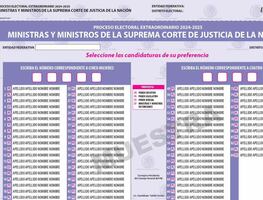Más Información

Las noticias nacionales más consultadas de EL UNIVERSAL en 2024; Sheinbaum, “El Mayo” Zambada y Mpox

Alito Moreno urge a cambiar estrategia contra delincuencia; pide poner fin a tragedia de homicidios en gobiernos de Morena

SRE lamenta muerte de ministro Abel Escartín Molina; se desempeñaba en Embajada de México en Reino Unido

INE aprueba 4 diseños de boletas para elección del Poder Judicial; pendientes las de jueces y magistrados

En comisiones, INE avanza con capacitación electoral para elección judicial; aprueban materiales didácticos de apoyo
Researchers from the National Polytechnic Institute (IPN) have designed a Waste Management Plan for Primary and Secondary Batteries in order to reduce the risks and environmental impact of batteries used in electronic devices.
Brenda Domínguez Santillán, Luisa Martínez Hernandez, graduates in Environmental Engineering from the Interdisciplinary Professional Unit of Biotechnology (UPIBI)
and their advisor Saúl Hernandez Islas , claimed that the project offered preventive mechanisms and planning to unite synergies and promote public policies to reduce the environmental risk of battery use.
"This will not be limited to a temporary collection center, it will help us learn to identify and manage this type of waste. Our plan will help promote consumption habits that will generate less waste to help mitigate climate change," said Hernandez Islas in a statement from the IPN.
The head of the Environmental Engineering degree at UPIBI indicated that the management of batteries is currently deficient, and the programs implemented to sort waste have lacked promotion and monitoring. The final destination of batteries after their useful life is unknown.
He underlined that rechargeable batteries are not consumed enough and can replace up to 200 primary batteries with due care.
He stressed that this initiative consists of several stages that abide with all corresponding regulations of each of the government sectors such as source reduction, separation-classification, identification-correct packaging, and battery collector .
"This sustainable project cannot begin without environmental education based on values and actions to reduce the use of batteries. The first thing we need to do is raise awareness," he said.
According to a study by UPIBI, in the Metropolitan Zone of the Valley of Mexico (MCMA) it is estimated that 64 percent of the inhabitants of Mexico City consume from one to two batteries a month ; 30 percent from three to five , and the remaining 6 percent more than six , which represents a total generation of 124 million 963 thousand 449 batteries a year .
AA, AAA, C and D-type batteries are used by 44 percent of the population
; rechargeable batteries by 29 percent, and 24 percent use lithium-ion batteries for cell phones, laptops and cameras), while button batteries are the least frequent, used by only three percent of the population .
dm






